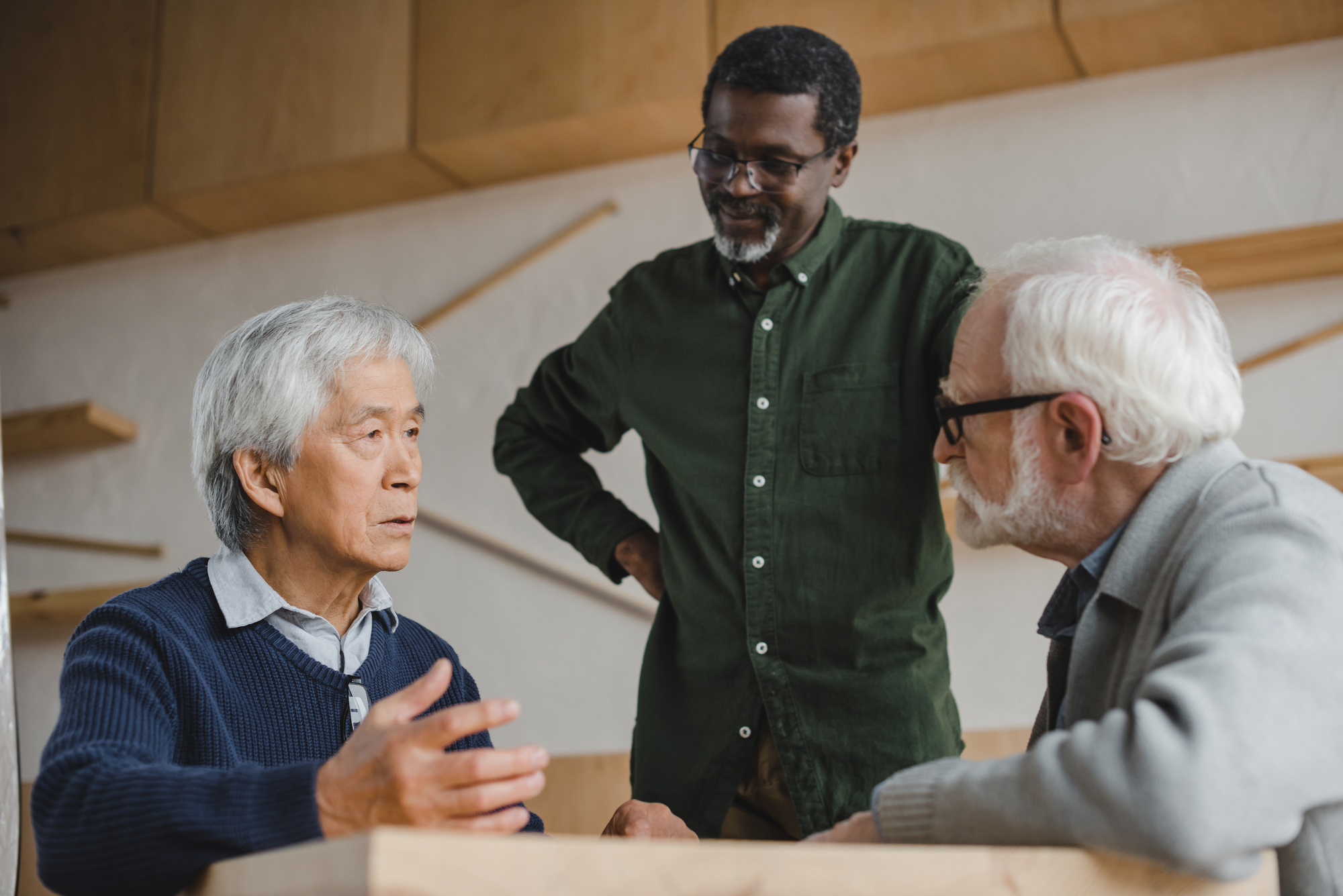1. Take care of your overall health.

This one might seem like a no-brainer (no pun intended), but it’s the cornerstone of mental well-being. A person will naturally be able to think more clearly if they’re well-rested, well-nourished, and well-hydrated.
In simplest terms, a healthy brain is a quick-thinking brain.
Make sure to get solid, restorative sleep whenever possible. Additionally, a healthy diet that’s full of good fats can work wonders for your brain. Essential fatty acids such as the Omega-3s found in flax seeds, walnuts, chia, salmon, mackerel, walnuts, and purslane have a huge impact on our mental acuity.
2. Do puzzles and brain teasers.

Do you like creative puzzles? We’re not talking about those multi-piece images that take ages to assemble, but rather brain teasers that you can solve with a paper and pencil.
Word searches, mazes, and riddles are all wonderful for helping to prod your brain into quicker activity.
*Note: Try to use printed books or printouts rather than apps for this one. Most of us spend far too much time on screens, and the blue light from them can mess with our circadian rhythms and melatonin levels. Try to take regular breaks from phones and pads as you work your brain out.
3. Practice discerning pertinent information from “filler.”

In any given situation approximately 20% of the information you’re given is essential. The remaining 80% is irrelevant, and may even conceal what it is you need to focus on.
So when you’re being given instructions or advice or information, try to hone in on what’s important and what’s not. Let go of the filler. Don’t allow it to clutter your thinking because it will only slow you down.
4. Play word creation and association games.

Have you ever played the game “Boggle” before? It’s an older game in which 14 random letters are chosen, and you need to create as many words from them as possible. This is a great brain workout, as it combines pattern recognition with creativity.
Another option similar to this one is a rhyming game. You can do this alone or with friends, with pen and paper or verbally. Just choose a word and try to come up with as many other words that rhyme with it as you can.
Like this:
Stress – mess, depress, access, compress, bless, confess, etc.
Another one along this line is the “-ty” game. In this one, you and another person (or people) try to come up with tons of words that end with the suffix “ty”. The first person to repeat what another one said is either out of the game, or buys the next round.
Example:
Normality, tonality, ferocity, finality, loyalty, audacity, capacity, etc.
5. Practice playful debate.

Get some of your friends together and have some playful debates. Choose some topics, and practice arguing for or against them. Take turns on different sides so you learn how to defend as well as promote, and see how well you can bring up salient points on the spot.
The key here is to be able to debate with logic and reason, without getting angry, loud, or abusive. Stoicism is your friend, and being able to express your points and ideas without getting emotional about it will lend strength to your argument.
6. Learn a new language.

Learning a new language (even just the basics) will have the same effect on your brain as hand-eye coordination games. They form new pathways, and keep your mind active and healthy.
If you really want to challenge yourself, then try to learn a language that uses a different alphabet than the one(s) you’re used to. Icelandic, as an example, uses the Latin alphabet mixed with a few old Norse runes, so it’ll be easier for native English speakers to pick up.
In contrast, Arabic, Japanese, Russian, and Inuktitut will be significantly more challenging, as they use phonetic glyphs, syllabograms, and alternative script formations in their written form.
Even just learning a few new words in other languages audibly rather than visually can help those new pathways to form. Try something simple like learning how to say “thank you” or “good morning” in four different tongues. Then increase that number until you remember them all clearly. Add more words as you see fit.
7. Memorize common fallacies.

You’ve probably experienced several situations in which someone tried to win a debate by using an argument that didn’t feel quite right to you. They most likely used logical fallacies in their argument, expecting to win by either obfuscating facts or twisting them into weird non-logic.
If you aren’t yet familiar with logical fallacies, definitely learn about them!
One of the most common ones is the Ad Hominem attack, which implies that a person’s ideas or testimony are irrelevant because of that person’s character, health, race, religion, or education.
For example: “Your opinion about politics is irrelevant because you’re on antidepressants,” or “Your ideas are invalid because you don’t have a PhD in the subject.”
Once you’ve memorized these fallacies, you’ll be able to recognize them instantly when and if someone tries to use one. Then you call them out on it and take the wind out of their argument.
8. Spend time playing memory card games.

Take an even number of cards consisting of matching pairs. Shuffle them and then lay them out on a tabletop. Turn over two at a time to see if you make a match.
If you do, then you remove those from the table. Otherwise, you keep turning them over two at a time, trying to remember which card you’ve seen where.
You can play this as solitaire, or with a friend/partner. There’s no “winning,” but rather it’s an opportunity for everyone involved to give their memory cells a gentle workout. Think of it as a flow yoga session rather than high intensity interval training.
9. Play a game called “What’s Different?”

Did you ever play this game when you were a kid? It’s wonderful for increasing your powers of observation plus spatial memory awareness. You’ll need at least one other person to play it.
You take a few minutes to really look around the room you’re in, and then leave. While you’re out, the other person (or people) make a few changes. Maybe they rearrange some items on a shelf, add an extra pillow onto the couch, or remove an item.
Then you come back into the room and try to figure out what’s changed.
You wouldn’t believe how helpful this can be in many different aspects of your life.
10. Take things apart and put them back together.

It’s immensely satisfying to be able to disassemble and reassemble something intricate. You need to remember how everything fits together, and then figure out how to make it work again after its pieces have been scattered all over the floor.
Warning: do NOT do this with any of the household appliances, nor any of your partner’s belongings, without express permission. Their retribution may be swift and painful if you fail to reassemble everything into proper working order.
You can always work on jigsaw puzzles or IKEA furniture instead.
11. Try some hand-eye coordination exercises.

Pick up some tennis balls and teach yourself how to juggle. Take up tennis with a friend or play ping pong solo against a wall.
Or start playing console video games. Seriously, there have been medical papers written about how effective playing video games can be for speeding up mental function and reaction times.
All of these pastimes require you to think and physically react quickly. Your eyes and mind analyze the objects’ speed and trajectory, then calculate what actions you need to take in order to hit or catch them.
This translates into the “real world” by also speeding up other reactions, like responding to medical emergencies, driving, and overall quick thinking.
12. Try some timed writing exercises.

Write 40 or so different writing prompts on pieces of paper and toss those into a jar. Then pull one out, set a timer for three minutes, and write on that topic until the timer goes off. You can either type or write by hand – your call.
When you’re done, count how many words you’ve written. This is obviously a lot easier if you’ve typed it, thanks to that handy “word count” tool up there. Do the same thing the next day and try to increase your word count within that time limit. Oh, and the writing actually has to make sense. You can’t just mash your face into the keyboard repeatedly to increase character count.
Doing this forces your mind to get creative under pressure. You only have that short period of time to gather your thoughts and express them as eloquently as possible.
13. Practice intentional variety.

Take new routes home from work, or find new neighborhoods to walk your dog through. Mix up your routines, even if it’s as simple as starting your grocery shopping at the opposite end of the shop than you usually would.
Try tasting new flavors, or entirely new foods. Listen to music you’ve never heard before. Immerse yourself in things that challenge and inspire you and keep you engaged, rather than checking out and plodding through whatever you’re doing.
14. Make time for silent solitude.

Most of us are inundated with sensory stimuli from the moment we wake to the second we fall asleep. We’re lucky if we can get a full night of uninterrupted sleep, but that’s also quite rare. Children’s needs, traffic noise, loud neighbors… all of these can jolt us from slumber several times a night.
Arrange regular times in which you’ll be able to sit or lie down uninterrupted. Send the family out on errands and invest in good noise-cancelling earplugs if needed. Let your mind and your senses rest without the need to “respond” to anything.
Some people respond well to long showers to help them decompress. Or you might go so far as to pay for some time in a sensory deprivation tank. Whatever works for you.
15. Consume a little “junk food” for the mind.

Do you take part in any activities that just let your mind blank out for a little while?
Some people zone out when going for walks, while others do so with repetitive tasks like yarn winding or digging. Or binge-watching several seasons of a favorite show on Netflix.
Basically, something that allows them to go into mental autopilot.
We can’t be “on” all the time, even though we’re often expected to be so. We can’t expect farm fields to produce nonstop – winter allows them time to rest and be replenished. Similarly, you won’t be able to think quickly if you never have an opportunity to rest your mind.
Take part in activities that let you regroup rather than exhausting you.
Remember that there’s no “one-size-fits-all” approach here. An activity that one person considers fun and helps them to think more quickly can frustrate and upset another.
Mix and match the tips that resonate best with you in order to design your own unique program, and be creative in terms of incorporating other skills and practices.
There are no right and wrong answers when it comes to training yourself to think faster. The only way you can fail in this endeavor is if you don’t put any effort into the attempt.








